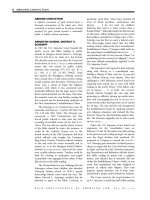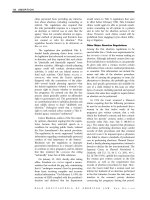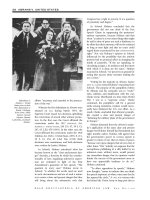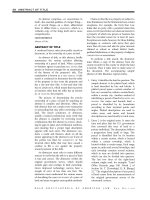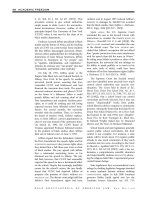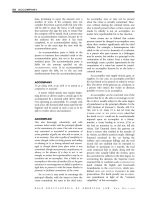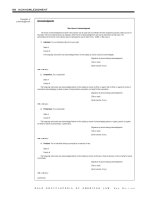Gale Encyclopedia Of American Law 3Rd Edition Volume 1 P29 pptx
Bạn đang xem bản rút gọn của tài liệu. Xem và tải ngay bản đầy đủ của tài liệu tại đây (347.02 KB, 10 trang )
The ACLU national headquarters is in New
York City. The group maintains a legislative
office in Washington, D.C., and a regional office
in Atlanta, along with chapters in each state.
These state chapters follow the decisions of the
national executive board yet are also free to
pursue cases on their own.
FURTHER READINGS
ACLU. ACLU’s Seventy-Five Most Important Supreme Court
Cases. Briefing paper.
———. The ACLU Today. Briefing paper.
———. Church and State. Briefing paper.
———. Guardian of Liberty. Briefing paper.
American Civil Liberties Union. Available online at www.
aclu.org (accessed September 17, 2009)
Hershkoff, Helen. 1997. The Rights of the Poor: The
Authoritative ACLU Guide to Poor People’s Rights.
Carbondale: Southern Illinois Univ. Press.
Walker, Samuel. 1999. In Defense of American Liberties: A
History of the ACLU. New York: Oxford Univ. Press.
CROSS REFERENCES
Baldwin, Roger Nash; Bill of Rights; Civil Rights; Frankfurter,
Felix; Palmer, Alexander Mitchell; Strossen, Nadine M.
AMERICAN FARM BUREAU
FEDERATION
The American Farm Bureau Federation (AFBF) is
a
NONPROFIT, nonpartisan organization dedicated
to promoting, protecting, and representing the
interests of U.S. farmers. More than five million
members in 50 states and Puerto Rico belong to
the AFBF, making it the largest U.S. farm
organization. The AFBF is a federation of 2,800
county farm organizations, which elect represen-
tatives to state farm bureaus. The organization
maintains its general headquarters in Park Ridge,
Illinois, and has an office in Washington, D.C.
From these offices the AFBF staff offers many
services and programs for state and county farm
bureaus and members. As of 2009 the AFBF held
more than $14 billion in assets.
The first county farm bureau was formed in
Broome County, New York, in 1911. The word
bureau in farm bureau is used because the first
organization was formed as a “bureau” of the
local chamber of
COMMERCE. Missouri was the
first state to form a statewide organization of
farm bureaus in 1915. The AFBF was founded
in 1919 when a small group of farmers from 30
state bureaus gathered in Chicago, Illinois. The
AFBF soon became a voice for agriculture at the
national level,
LOBBYING Congress for passage of
legislation favorable to farmers.
The AFBF relies on its 2,800 county bureaus
for direction and support. Thousands of volun-
teer leaders serve on county farm bureau boards
and committees. Members organize social out-
ings, educational workshops, political action
and community forums, and other programs
and service s for farm families.
State bureaus adopt policies and name
delegates to represent them at the AFBF annual
meeting. Policies adopted by
VOTING delegates
govern the federation. These policies de al with
many issues, including the use of natural
resources,
TAXATION, property rights, services to
the farm community, trade, food safety and
quality, and other issues that affect rural America.
The AFBF has historically been a conserva-
tive organization, favoring flexible price sup-
ports for crops and a minimum of government
regulation and oversight. Its government rela-
tions division employs a number of registered
lobbyists who are specialists on farm policy,
trade, budget and taxes, farm credit, labor,
transportation, conservation, and the environ-
ment. These individuals maintain daily contact
with Congress and regulatory agencies and
appear before congressional committees.
The AFBF’s
PUBLIC POLICY division is respon-
sible for research, education, and policy support
for AFBF and the state farm bureaus. Staff
members engage in research projects on a variety
of current issues, includ ing property rights,
health care, clean water, endangered species,
animal welfare, farm programs, and dairy policy.
One of the hottest issues that began in the
1990s and continues into the 2000s concerns the
current and future role of biotechnology in
agriculture. Biotechnology and other technologi-
cal developments such as computers, lasers, and
robots are also issues closely followed byAFBF and
the county and state farm bureaus. Additionally,
the AFBF has sought to play a major role in such
areas as the continuing development of renewable
fuels and international trade. The division coordi-
nates several special farm bureau activities,
including
COMMODITY advisory committees, annual
crop surveys, and various national seminars and
conferences on policy issues.
The federation’s communication division
operates a computerized marketing, news, and
weather system that delivers the latest news,
market information, U.S.
DEPARTMENT OF AGRI-
CULTURE
news, and agricultural weather reports
to subscribers by satellite.
GALE ENCYCLOPEDIA OF AMERICAN LAW, 3RD E DITION
268 AMERICAN FARM BUREAU FEDERATION
The American Farm Bureau Foundation for
Agriculture, founded in 1967, funds research on
agricultural issues. The foundation is funded by
gifts from individuals, county and state farm
bureaus,
CORPORATIONS, and foundations. The
foundation has funded research on animal waste
management, pesticide use, new methods of
helping endangered species, and animal welfare
education. The foundati on is also active in
numerous educational outreach programs in-
cluding “Educating About Agriculture,” awards
and contests, farm tours and field days, garden
and planting projects, mobile classroom units,
newsletters, books, and videos. The AFBF
sponsors scholarships for teachers as well as a
number of grants.
FURTHER READINGS
American Farm Bureau. Available online at .
org (accessed May 11, 2009).
Howard, R. P. 1982. James R. Howard and the Farm Bureau.
Ames, IA: Iowa State Univ. Press.
Woell, Melvin. 1990. Farm Bureau Architects: Through Four
Decades. Dubuque, IA: Kendall-Hunt.
CROSS REFERENCE
Farm Credit Administration.
AMERICAN FEDERATION OF LABOR—
CONGRESS OF INDUSTRIAL
ORGANIZATIONS
The American Federation of Labor-Congress of
Industrial Organizations (AFL-CIO) is a volun-
tary federation of 56 national and international
labor unions. It comprises 65 national union
affiliates, 45,000 local unions, 51 state federat ions
(including Puerto Rico), 570 central labor
councils, and a membership of more than 10
million workers. The organization, which has
had enormous political influence since the 1930s,
is headquartered in Washington, D.C. However,
the AFL-CIO’s influence was weake ned during
the mid-2000s when two major national labor
unions withdrew from the AFL-CIO.
The AFL was formed in 1886 as a loose
confederation of 25 autonomous national trade
unions with more than 316,000 members.
Renouncing identification with any political
party or movement, the AFL concentrated on
pursuing achievable goals, such as higher wages
and shorter work hours. Members were encour-
aged to support politicians who were friendly to
labor, no matter their party affiliation.
During the 1930s the AFL became embroiled
in internal conflict. The trade unions that
dominated the AFL were composed of skilled
workers who opposed organizing the unskilled
or semiskilled workers on the manufacturing
production line. Several unions rebelled at this
refusal to organize and formed the Committee
for Industrial Organization (CIO). The CIO
aggressively organized millions of workers who
labored in automobile, steel, and rubber plants.
In 1938, unhappy with this effort, the AFL
expelled the unions that formed the CIO. The
CIO then formed its own organization and
changed its name to the Congress of Industrial
Organizations. By the 1950s, the leade rship of
both the AFL and CIO realized that a unified
labor movement was necessary. In 1955, the AFL
and the CIO merged into a single organization,
the AFL-CIO.
The AFL-CIO is primarily concerned with
influencing legislative policies that affect unions.
Its staff membe rs conduct research, set policy,
and
TESTIFY before congressional and state
legislative committees. More importantly, the
organization provides funds and volunteers to
labor-endorsed political candidates. Although
the AFL-CIO is a nonpartisan organization, it
traditionally has supported
DEMOCRATIC PARTY
candidates.
With the 1995 election of John J. Sweeney as
president, the AFL-CIO has made increased
union membership its highest priority. Although
Sweeney was subsequently reelected three times,
membership in U.S. trade unions has continued
to fall over the last several decades as the
manufacturing sector of the U.S. economy has
steadily declined. Union membership in 1954
comprised 34.7 percent of the workforce. By
2000, this number had declined to 13.4 percent,
and by 2007, only 12.1 percent of the workforce
were union workers.
Sweeney pushed the organization to recruit
women, minorities, low-paid workers, and
white-collar workers. In 2001 the AFL-CIO
launched the New Alliance Initiative with the
purpose of restructuring unions at the state and
local levels. However, Sweeney was not popular
with everyone associated with the AFL-CIO. In
2005, two major unions—the International
Brotherhood of Teamsters and the Service
Employees International Union—each voted
unanimously to withdraw from the AFL-CIO.
Heads of both unions cited concerns with the
AMERICAN FEDERATION OF LABOR 269
GALE ENCYCLOPEDIA OF AMERICAN LAW, 3RD E DITION
AFL-CIO’s direction as reasons for leaving the
organization. Total membership in the AFL-
CIO fell from more than 13 million in 2001 to
less than 11 million in 2009.
The day-to-day work of the federation is
carried out by 11 programmatic departments
including the Organizing Department; Field
Mobilization Department; Civil, Human and
Women’s Rights Department; and the Interna-
tional Affairs Department. Topics of major
importance to the AFL-CIO include manufactur-
ing,
CIVIL RIGHTS, the global economy, health care,
immigrant workers, minimum-wage issues, pen-
sions, and
SOCIAL SECURITY.
FURTHER READINGS
AFL–CIO Website. Available online at cio.
org/ (accessed May 11, 2009).
Edsall, Thomas B. 2005. “Two Top Unions Split from AFL-
CIO.” Washington Post.
AMERICAN INDIAN MOVEMENT
Founded in 1968, the American Indian Move-
ment (AIM) is an organization dedicated to the
Native American
CIVIL RIGHTS MOVEMENT . Its
main objectives are the
SOVEREIGNTY of Native
American lands and peoples, preservation of
their culture and traditions, and enforcement of
all treaties with the United States.
Despite the straightforwardness of its stated
objectives, AIM’s reputation was seriously harmed
by well-publicized and controversial incidents of
law-breaking,
VANDALISM, and violence, resulting in
the organization’s peak and decline within a few
years. Significant historical events include AIM’s
hostile occupation of Alcatraz Island (1969); the
“Trail of Broken Treaties” march on Washington,
D.C. (1971); occupation of Wounded Knee
(1973); and the Pine Ridge shootout of 1975,
which resulted in the controversial arrest and
IMPRISONMENT of the most famous AIM member,
Leonard Peltier. Following these events, the
organization’s visibility and viability as a political
force greatly declined.
History
Prior to the formation of AIM, issues involving
U.S. Indian–non-Indian relations had largely
faded away. Starting in the 1950s, the U.S.
government embarked on a serious policy plan
to terminate its responsibilities to Native Amer-
icans pursuant to extant treaties and agreements.
This action included the relocation of thousands
of reservation Indians to urban areas and the
TERMINATION of federal duties to two major tribes,
the Me nominee of Wisconsin and the Klamath of
Oregon. (Federal rights were restored to both a
few years later.) However, by the 1970s, reloca-
tion as well as termination policies were all but
abandoned.
A number of problems arose when Native
Americans left the reservations and inter-
mingled with local t owns. Native Americans
allegedly caused and/or became parties to local
disturbances or crimes. Moreover, after
WORLD
WAR II
and the KOREAN WAR, many Native
Americans who had served in the armed forces
no longer wanted to return to stereotypical
Indian lifestyles. As more intermingling and
merging occurred, other Native Americans
became increasingly intent on searching for
their cultural roots and maintaining their ethn ic
identities. They vowed not to be assimilated and
their views paralleled the ideals of other
CIVIL
RIGHTS
movements of the era. The most radical
elements to emerge from these militant Native
American groups ultimately formed the AIM,
which was intended as an indigenous version of
the
BLACK PANTHER PARTY.
During the summer of 1968, about 200
members of the Native American community in
urban Minneapolis, Minne sota, met to discuss
various issues, including slum housing, alleged
police brutality, unemployment, and alleged
discriminatory policies involving the local
American Indian
activist Glenn Morris
leads a protest against
the annual Colombus
Day parade in
Denver, Colorado.
AP IMAGES
GALE ENCYCLOPEDIA OF AMERICAN LAW, 3RD E DITION
270 AMERICAN INDIAN MOVEMENT
county’s WELFARE system. The group had been
impressed with media coverage of the Black
Panther policy of monitoring routine police
interrogations or arrests and adopted similar
tactics.
From the beginning, the group stirred
controversy in seeking attention. Mobilizing in
different cities and gaining momentum, it
employed increasingly negative tactics such as
holding an “anti-birthday party” for the United
States atop Mt. Rushmore on the Fourth of July;
painting Plymouth Rock bright red on Thanks-
giving Day 1970, and seizing the Mayflower
replica. All of these actions served to alienate
many would-be sympathizers. However, AIM
did get the media attention it desired, which
seemed only to spawn further controversy.
When the group organized a hostile occupation
of Alcatraz Island off the coast of California,
AIM finally became a force to be reckoned with,
just briefly.
Alcatraz
On November 9, 1969, a group of Native
American supporters, led by Mohawk Richard
Oakes, chartered a boat and set out to symboli-
cally claim the island of Alcatraz for “Indians
of all tribes.” By November 20 the gesture had
turned in to a full-scale occupation that ul timately
became the longest prolonged occupation by
Native Americans of a federal facility or federal
property.
Early use of Alcatraz Island by indigenous
peoples is difficult to reconstruct. Ancient oral
histories seem to support the view that at one
time Alcatraz was used as a place of isolation for
tribal members who had violated some tribal law
or taboo and were exiled or ostracized for
punishment. Earlier or concurrently, the island
changed hands several times during Spanish and
Portuguese explo rations, but ultimately it be-
came federal property and in time became the
site of the infamous federal prison once operated
there.
Many of the Indian occupiers of November
1969 were students recruited by Oakes from
UCLA, who returned with Oakes to Alcatraz
and began to live on the island in old federal
buildings. They ran a school and daycare center,
and began delivering local radio broadcasts that
could be heard in the San Francisco Bay area.
Initially the federal government placed an
effective barricade around the island and
insisted that the group leave; the government
did, however, agree to an Indian demand for
formal negotiations. The talks accomplished
nothing, as the Indian group insisted on a deed
and
CLEAR TITLE to the island. The group
continued occupation and the federal govern-
ment insisted they depart but took no aggressive
action to remove them. Officially, the govern-
ment adopted a position of non-interference
and hoped that support for the occupation
would fade. The FBI and Coast Guard were
under strict orders to remain clear of the island
and media attention began to dwindle.
The occupation continued all through 1970,
but by this time, internal problems among the
indigenous group caused the occupation to lose
momentum. Student recru its left to return to
classes at UCLA and were replaced by urban
recruits, many of whom had been part of the
San Francisco drug and hippie culture of the
time. Several rose in opposition to Oakes’s
leadership on the island, and Oakes ultimately
left after his teenaged stepdaughter fell to her
death in a building stairwell.
After several months of hostile occupation,
the federal government shut off electric power to
the island and removed the water barge that had
been supplying fresh water to the occupiers. A fire
broke out, and both sides blamed the other for
the loss of several historic buildings. Splintered
leadership on the island resulted in the loss of a
common voice with which to
NEGOTIATE with the
government. When the occupiers began strip-
ping the remaining buildings of copper wiring
and tubing, the press turned on them and began
publishing stories of assaults, drugs, violence, and
the trial of three Indians found guilty of selling
600 pounds of copper.
With government patience growing thin,
then-president
RICHARD NIXON finally approved a
peaceful removal plan, to be conducted with as
little force as possible and when the least number
of people were on the isl and. On June 10, 1971,
FBA agents, armed federal marshals, and special
forces police removed five women, four children,
and six unarmed men from the island.
Trail of Broken Treaties
In November 1971 AIM organized what it
called the Trail of Broken Treaties, a march on
Washington, D.C., involving approximately
1,000 angry Native Americans. It ended with
the occupation of the Bureau of Indian Affairs
GALE ENCYCLOPEDIA OF AMERICAN LAW, 3RD E DITION
AMERICAN INDIAN MOVEMENT 271
(BIA) headquarters. After taking over the
offices, AIM protesters seized large numb ers of
files from the BIA offices and caused more than
$2 million in
DAMAGES to the trashed building.
They also presented President Nixon with 20
demands for immediate action. The Nixon
administration provided $66,000 in transporta-
tion monies in return for a peaceful end to the
takeover. It also agreed to appoint a Native
American to a BIA post. Again, the real success
for AIM was in getting some media attention
and in heightening public awareness of unre-
solved Indian issues.
Wounded Knee
The tiny village of Wounded Knee, South Dakota,
is the historic site of an infamous 1890 massacre
of Native Americans (the last) by the U.S.
Cavalry. The original site and burial ground
became part of the Pine Ridge Indian reservation
in that state.
In 1973 about 200 members of the local
Oglala Lakota Indians, led by AIM members,
seized the village of Wounded Knee (a Catholic
church, trading post, and post office) and
declared it to be an independent nation. Their
single demand was the return of the Great Sioux
Nation (a sovereign parcel of
REAL ESTATE
comprising the entire western half of South
Dakota) allegedly promised to them by the
United States in the Fort Laramie Treaty of 1868.
Just prior to this development, on the
nearby Pin e Ridge reservation, tribal council
president Dick Wilson (a Native American) had
secured a tribal council order prohibiting AIM
members from attending or speaking at reser-
vation meetings or public gatherings. He
considered AIM members to be lawless misfits
bent on agita ting the populace. AIM members,
in return, accused Wilson of nepotism, corrup-
tion, and mismanagement of tribal monies.
A group of Wilson supporters, locally referred
to as the “goon squad,” began harassing and
threatening AIM members. The Lakota Indians
invited AIM to meet with their group, and both
decided to take a stand at Wounded Knee. At
this point, the federal government, including
the BIA, remained neutral, clai ming the stand-
off was an internal tribal dispute.
When AIM occupiers built fortifications and
took up arms and munitions, both Wilson
and the federal government (FBI , U.S. marshals,
and BIA police) moved in. In the well-publicized
71-day occupation that followed, two AIM
members were killed. Ultimately, AIM leaders
negotiated a “peace pact” with the government
stipulating that the activists would be treated
fairly and that the federal government would
conduct a fair review of several treaties.
Although the immediate stand-off was
defused, tensions between Wilson’s goon squad
and AIM members continued over the next
several years. Dozens of AIM members, includ-
ing early foundi ng members Russell Means and
DENNIS BANKS, were indicted on dozens of
charges related to the Wounded Knee stando ff.
The charges were ultimately dropped when a
federal judge acknowledged spurious activity
and involvement by the FBI.
Pine Ridge
Wilson’s t ribal leadership at the Pine Ridge
reservation was reportedly federally sanctioned
and supported. Allegations arose at the trials of
AIM members that goon squad members were
paid with BIA monies and that many of the
members were in fact off-duty BIA police. Several
murders occurred on the reservation and were
never fully investigated. For its part, the FBI
maintained that it was an investigatory rather
than enforcement agency, a position that further
exacerbated the regional tension and fear.
In June 1975 two FBI agents in an unmarked
car and clad in civilian clothes chased a pickup
truck into an isolated area near an AIM
encampment. During the resulting shootout,
the two FBI agents were shot and killed, along
with one Indian activist. Over the next several
days, more than 300 FBI agents swarmed the
reservation, followed by officers making dozens
of arrests and prosecutions. Ultimately, AIM
activist Peltier was tried and convicted for his role
in the FBI killings, receiving two life sentences.
His trial and
CONVICTION remained shrouded
with allegations of suppressed evidence, coerced
WITNESSES, and a fabricated MURDER weapon.
Later Years
Following the Pine Knee incident, AIM declined
rapidly in both leadership and momentum. It
held its last national unified event in 1978 and
the following year dismantled as a national
organization in favor of independent regional
chapters. Means and Banks were in and out of
court for years defending their leadership roles in
the 1973 and 1975 shootouts. Eventually, both
were acquitted of all significant charges. Bank s
GALE ENCYCLOPEDIA OF AMERICAN LAW, 3RD E DITION
272 AMERICAN INDIAN MOVEMENT
went on to found another Indian organization,
the Sacred Run, devoted to spiritual renewal and
environmental issues. In 2007, Means made news
when he announced that the Lakota Indian tribe
would withdraw from treaties with the United
States. However, several other tribal leaders
opposed Means’ stance.
Peltier remained in prison. As of 2003, the
FBI refused to release nearly 500 documents on
Peltier, being withheld on grounds of “national
security.” In 2009 Peltier’s family reported that
the 64-year-old had been beaten by a gang of
inmates at the U.S.
PENITENTIARY in Lewisburg,
Pennsylvania. Some called for President
BARACK
OBAMA
to PARDON Peltier.
In 1978 Congress passed the American
Indian Religious Freedom Act (AIRFA)(42 U.S.
C.A. § 1996), designed to review and update
federal policies regarding such matters as Native
Americans’ right to access sacred grounds and
legal rights to practice their traditional reli gions.
Reviews and recommendations were made.
Pursuant to this action, Congress passed the
Native American Graves Protection and Repa-
triation Act, Public L. No. 101-601, 104 Stat.
3048, in 1990 but in that same year, the U.S.
Supreme Court reiterated its 1988 ruling that
AIRFA was a policy statement and not law. As
such, there was no
LEGAL RIGHT to the protection
of sacred sites or the religious use of peyote in
the Native American
RELIGION. Lyng v. Northwest
Indian Cemetery Protection Association, 483 U.S.
439, 107 S. Ct. 2924, 97 L. Ed. 2d 364 (1988).
New sacred land protection legislation was
again introduced in 2002, but the legislation
died in committee.
FURTHER READINGS
American Indian Movement Website. Available online at
(accessed May 11, 2009).
Churchill, Ward. June 1997. “A Force, Briefly, To Reckon
With.” Progressive.
Johnson, Troy. “We Hold the Rock: The American Indian
Occupation of Alcatraz Island.” Indians of North
America. Long Beach: California State Univ. Press.
Marshall, Joseph M., III, and Sicangu Lakota. 2000.
“Wounded Knee Takover, 1973.” Encyclopedia of North
American Indians. Houghton Mifflin.
Oswalt, Wendell H., and Sharlotte Neely. 1994. This Land
Was Theirs. 5th ed. Mountain View, CA: Mayfield.
Singer, Daniel. July 18, 1994. “Free Peltier!” Nation.
CROSS REFERENCES
Native American Graves Protection and Repatriation Act of
1990; Native American Rights.
AMERICAN ISRAEL PUBLIC AFFAIRS
COMMITTEE
The American Israel Public Affairs Committee
(AIPAC) is a national advocacy group that
lobbies for U.S. support to the nation of Israel.
Founded in 1951, AIPAC has grown into a
100,000-member organization that is recog-
nized as one of the most influential foreign
policy groups in the United States. AIPAC has
lobbied Congress for U.S. foreign aid to Israel
since 1951, when it helped defeat several efforts
to cut aid for the resettling of hundreds of
thousands of Holocaust
REFUGEES in Israel. In
addition, AIPAC has lobbied for U.S. military
aid to Israel and has helped preserve the special
relationship that has existed between the United
States and Israel since the United States
recognized the nation of Israel in 1948.
AIPAC is headquartered in Washington,
D.C. Members of its staff maintain an active
presence in the halls of Congress, attending
committee sessions and reviewing legislation
that may affect the relationship between the
United States and Israel. AIPAC estimates that it
monitors 2,000 hours of congressional hearings
annually. Research staff members analyze per-
iodicals and documents in five different lan-
guages, amassing a large archive of information
on hundreds of issues, including foreign aid,
antiterrorism initiatives, and programs that
promote United States-Israel strategic coopera-
tion. AIPAC staff members also work with key
officials in developing legislation and policy,
presenting concepts and information that are
moved into the legislative process. AIPAC
lobbyists hold 1,000 meetings annually with
congressional offices.
AIPAC also works with aspiring politicians.
During the 1994 elections, representatives of
AIPAC met with 600 congressional candidates.
Since 1990, AIPAC has worked to educate these
new legislators about the relationship between
the United States and Israel and the key issues
critical to maintaining that relationship. AIPAC
staff frequently meets with every freshman
representative. Likewise , AIPAC representatives
meet with members of new presidential admin-
istrations, including the administration of
President
BARACK OBAMA in 2009.
AIPAC regional staff members travel to
more than 600 communities a year to train
AIPAC members to be effective advocates for
United States-Israel relations. AIPAC works in
GALE ENCYCLOPEDIA OF AMERICAN LAW, 3RD E DITION
AMERICAN ISRAEL PUBLIC AFFAIRS COMMITTEE 273
every congressional district, especially those
districts with little or no Jewish population.
AIPAC conducts small meetings and statewide
workshops, giving its members the opportunity
to become involved in grassroots
LOBBYING.
The influence of AIPAC remains strong.
The United States has appropriated billions of
dollars to support Israel, and AIPAC has been
influential in building and maintaining support
for the Jewish state. Additional funds have been
appropriated to help
SETTLE Jewish refugees in
Israel. AIPAC has also maintained congressional
support for Israel’s position in the Middle East
peace process, arguing that attempts to distance
the United States from Israel’s position only
encourage its Arab neighbors to ask for
unilateral concessions. AIPAC belie ves that the
peace process will only achieve results if the
close working relationship between the United
States and Israel continues.
Following the
SEPTEMBER 11TH ATTACKS in
2001, AIPAC has stepped up its agenda to make
sure that the United States continues to ensure
Israel’s security by working with Congress to
isolate and financial ly constrict such groups as
Hamas, Hezbollah, and Palestinian Islamic Jihad.
AIPAC has continued to support U.S. efforts to
isolate and pressure Palestinian authority chair-
man Yasir Afarat to stop bombings and
SUICIDE
missions within Israel. Through its Web site, the
organization keeps members updated on protec-
tive measures taken by the Israeli people as the
United States initiated war with Iraq in 2003.
More recent efforts have focused on tensions
with Iran, which has sought to develop a nuclear
program. AIPAC has supported dozens of bills
related to Iran, including the Iran Freedom
Support Act, Pub. L. No. 109-293, 120 Stat.
1344 (2006), which renewed sanctions.
FURTHER READINGS
American Israel Public Affairs Committee. Available online
at (accessed May 12, 2009).
Bass, Warren. 2003. Support Any Friend: Kennedy’s Middle
East and the Making of the U.S. Israel Alliance. New
York: Oxford Univ. Press.
Wright, John R. 1995. Interest Groups and Congress:
Lobbying, Contributions, and Influence. New York:
Addison-Wesley.
AMERICAN LEGION
The American Legion is a wartime veterans’
organization chartered by Congress in 1919.
The American Legion has almost three million
members in nearly 15,000 American Legion
posts worldwide. These posts are organized into
55 departments, one each for the 50 states, the
District of Columbia, Puerto Rico, France,
Mexico, and the Philippines. The American
Legion’s national headquarters is in Indianapo-
lis, Indiana, with additional offices in Washing-
ton, D.C. Though volun teer members do most
of the work of the American Legion, the
national organization has a regular full-time
staff of about 300 employees.
Eligibility in the American Legion is based on
honorable service in the U.S. armed forces during
WORLD WAR I, WORLD WAR II,theKOREAN WAR,the
VIETNAM WAR, and military operations in Lebanon
(1982–84); Grenada (1982–84); Panama (1989–
90); and the Gulf Wars (1990–). Membership is
based on the period of service, not the place of
service, so an individual does not have to be
stationed in a combat zone to be eligible.
Members may participate in a low-cost life
insurance program and may receive discounts
on moving expenses, car rentals, hotel and motel
rentals, eyewear, and prescription drugs. Ameri-
can Legion service officers provide free advice
and guidance to veterans who need to deal with
the Department of Veterans Affairs (VA) about
benefits and other issues.
The American Legion sponsors many com-
munity activities and programs. Students show-
ing the highest qualities of citizen ship are
recognized with an American Legion School
Medal Award. More than 30,000 students in
elementary, junior high, and senior high schools
are recognized annually for their
COMMITMENT to
honor, courage, scholarship, leadership, and
service. The organization also awards 10 national
college scholarships each year. At the state level,
49 departments host Boys State programs each
summer for outstanding high school juniors.
Local posts sponsor nearly 28,000 young men
each year to attend the week-long government
education program. Two outstanding leaders
from each of these Boys State programs are
selected to attend the American Legion Boys
Nation in Washington, D.C. The American
Legion Auxiliary conducts parallel programs for
young women through Girls State and Girls
Nation.
Many local posts sponsor Junior Shooti ng
Clubs, which provide training in gun safety and
marksmanship for students ages 14 through 20.
However, the American Legion is probably best
GALE ENCYCLOPEDIA OF AMERICAN LAW, 3RD E DITION
274 AMERICAN LEGION
known for its sponsorship of youth baseball
programs. The American Legion spends mil-
lions each year to sponsor more than 4,800
baseball teams representing more than 89,000
players. Champions from the state level meet on
the national level in the American Legion World
Series tournament.
The American Legion has always been a
strong advocate for U.S. veterans, appearing
before congressional committees to submit
information and viewpoints on pending legisla-
tion. The Veterans Affairs and Rehabilitation
Commission (VAR) is a cornerstone of the
American Legion, overseeing federally mandat-
ed programs provided by the VA for veterans
and their dependents. VAR services include
assistance with medical care, claims and appeals,
insurance programs, burial benefits, and veter-
ans’ employment. Staff members also commu-
nicate with administrators of state veterans’
affairs programs.
American Legion volunteers give more than
one million hours of service to disabled veterans
annually. Field representatives from the Ameri-
can Legion’s Washington office systematically
visit VA medical centers, nursing homecare
units, and outpatient clinics to evaluate their
programs and facilities. The field representatives
report resource needs and areas for improvement
to the VA headquarters in Washington, D.C.
For a number of years the Legion and other
members of the Citizens Flag Alliance have
continued to lobby Congress for a
CONSTITUTIONAL
AMENDMENT
that would impose penalties for
desecration of the U.S. flag. The Legion has also
been active in
LOBBYING for mandatory recitation
of the Pledge of Allegiance in public schools.
After the
SEPTEMBER 11TH ATTACKS in 2001, the
Legion established the American Legion Septem-
ber 11 Memorial Scholarship to help defray
college costs for children of deceased military
personnel.
FURTHER READINGS
American Legion. Available online at
(accessed May 12, 2009).
Moley, Raymond. 1975. The American Legion Story. West-
port, CT: Greenwood.
Rumer, Thomas. 1990. The American Legion: An Official
History, 1919–1989. New York: Evans.
AMERICAN MEDICAL ASSOCIATION
The American Medical Association (AMA) is a
federation of state and territorial medical
associations. The AMA seeks to promote the
art and science of medicine, the medical
profession, and the betterment of public health.
Its purposes include obtaining, synthesizing,
integrating, and disseminating information
about health and medical practice; setting
standards for medical ethics, practice, and
education; and being an influential advocate
for physic ians and their patients.
The AMA was founded in 1847. At its
organizing convention, the AMA adopted the
first code of ethics in the United States, a detailed
document that addressed the obligations of
physicians to patients and to each other and the
duties of the profession to the public at large. The
delegates also adopted the first national standards
for medical education through a
RESOLUTION
establishing prerequisites for the study of medi-
cine. Since that time, the AMA has grown into a
large organization with great influence over
issues involving health care and medicine. It is
headquartered in Chicago, Illinois.
The AMA speaks out on issues important to
the medical community. AMA policy on such
issues is decided through a democratic process, at
the center of which is the AMA House of
Delegates. The house is comprised of physician
delegates from every state, the national medical
specialty societies, the
SURGEON GENERAL of the
United States, and sections representing organized
medical staffs, young physicians, resident physi-
cians, medical students, and medical schools.
Before the opening of the House of Dele-
gates, which meets twice per year, individual
committees consider resolutions and reports
in hearings open to all AMA members. Each
committee prepares recommendations for the
delegates. The house then votes on these
recommendations, deciding the AMA’s formal
position and future action on an issue.
The AMA has been active in numerous
healthcare initiatives that affect the U.S. popu-
lace as a whole. In the 1990s the AMA launched
a campaign against family violence and violence
in schools and called on
TOBACCO companies to
refrain from engagin g in advertising practices
that target children. The AMA also launched a
national campaign against so-called “drive-
through” baby deliveries that ended with the
passing of legislation requiring insurance com-
panies to provide appropriate hospitalization
and maternity stays.
GALE ENCYCLOPEDIA OF AMERICAN LAW, 3RD E DITION
AMERICAN MEDICAL ASSOCIATION 275
In 2000 the AMA announced the first stage
of its health literacy campaign that was aimed at
increasing patient comprehension of basic
healthcare communications such as prescrip-
tion instructions and insurance forms. The
AMA also began an initiative to reduce under-
age drinking. In a more controversial area, the
AMA has been active in medical
LIABILITY reform
efforts in several states. The AMA has main-
tained the position that the problems of rising
healthcare costs are due to the costs of
MEDICAL
MALPRACTICE
suits and has vigorously supported
medical liability reform legislation.
The AMA opposed the creation of
MEDICARE
in the 1960s and during the 2000s has remained
opposed to national healthcare insurance. In the
late 2000s, the AMA advocated for reforms in
Medicare payment programs. The AMA also
called on Congress to end Medicare cuts caused
by economic downturns. In 2009, the AMA
opposed congressional proposals for a public
insurance plan. However, as Congress appeared
closer to passing a health care reform bill in
December 2009, the AMA expressed support for
the proposal.
The AMA is the world’s largest publisher of
scientific medical information. The Journal of the
American Medical Association (JAMA) is printed
in 12 languages and reaches physicians in 42
countries worldwide, making it the world’s
most widely read medical journal. The AMA
also publishes nine monthly medical specialty
journals as well as a newspaper of social and
economic health news, American Medical News.
Web site: />FURTHER READINGS
American Medical Association. Available online at http://
www.ama-assn.org/ (accessed June 13, 2009).
Kirkpatrick, David D. 2009. “Groups Back Health Reform,
but Seek Cover.” New York Times. September 11.
Pear, Robert. 2009. “Doctors’ Group Opposes Public
Insurance Plan.” New York Times. June 10.
CROSS REFERENCES
Health Care Law; Medicare.
AMERICAN PARTY
See KNOW-NOTHING PARTY.
AMERICANS WITH DISABILITIES ACT
See DISABILITY DISCRIMINATION.
v
AMES, JAMES BARR
James Barr Ames was born June 22, 1846, in
Boston. He achieved prominence as an educator
and concentrated his career efforts at Harvard
University.
James Barr Ames.
LIBRARY OF CONGRESS
James Barr Ames 1846–1910
❖
◆
◆
◆
◆
1846 Born,
Boston,
Mass.
1868 Graduated
Harvard College
1872 Received J. D.,
Harvard Law School
1877 Became
Professor of
Law at Harvard
1897 Helped found
Harvard Law Review
1899 Awarded Honorary
Doctor of Laws degree
from U. Penn
1895–1910 Dean of Harvard Law School
1904 Awarded Honorary Doctor of
Laws degree from Harvard
1910 Died,
Wilton, N.H.
1913 Lectures on Legal
History published
▼▼
▼▼
18251825
18751875
19001900
19251925
18501850
◆
◆
◆
❖
AN IMMORTAL RIGHT
TO BRING AN
ETERNALLY
PROHIBITED ACTION IS
A METAPHYSICAL
SUBTLETY THAT THE
PRESENT WRITER
CANNOT PRETEND TO
UNDERSTAND
.
—JAMES AMES
GALE ENCYCLOPEDIA OF AMERICAN LAW, 3RD E DITION
276 AMERICAN PARTY
A graduate of Harvard College in 1868,
Ames earned a master of arts degree in 1871 and
attended Harvard Law School in 1872. He
received several doctor of laws degrees from
various universities, in cluding the University of
Pennsylvania in 1899, Northwestern University
in 1903, and Harvard in 1904.
In 1868 Ames began his teaching career as
an instructor for a private school in Boston.
Three years later he began his professional
association with Harvard, acting as a tutor in
French and German until 1872 and continuing
as an instructor in medieval history for the next
year. From 1873 to 1877 he was an associate
professor of law; in 1877, he became a professor
of law. From 1895 to 1910 he performed the
duties of dean of the law school. In 1897 he
participated in the establishment of the Harvard
Law Review.
Ames distinguished himself as a teacher of
law by utilizing the
CASE METHOD introduced by
legal educator and former Harvard Dean
CHRISTOPHER COLUMBUS LANGDELL. Langdell’s ap-
proach presented principles of law in relation to
actual cases to which they were applied. By
studying the cases, a student of law was given an
accurate example of the law at work.
Ames extended his talents to the field of legal
literature. He is the author of Lectures on Legal
History, which was published in 1913. He died
January 8, 1910, in Wilton, New Hampshire.
CROSS REFERENCE
Legal Education.
v
AMES, SAMUEL
Samuel Ames was born September 6, 1806. He
graduated from Brown University in 1823 and
was admitted to the Rhode Island bar in 1826.
From 1841 to 1851 Ames represented
Providence in the Rhode Island general assem-
bly. During his
TENURE, he was a prominent
supporter of state authority in the “Dorr
Rebellion.” This
INSURRECTION occurred in 1842
as a
PROTEST against the limited VOTING rights
that existed in Rhode Island. The protest
resulted in a more liberal interpretation of the
right to
SUFFRAGE.
Beginning in 1856 Ames served as chief
justice of the Rhode Island Supreme Court. In
1861 he was the representative from Rhode
Island during a series of unsuccessful negotia-
tions to effect a peace between the North and
South during the Civil War. Ames died December
20, 1865, in Providence, Rhode Island.
CROSS REFERENCE
Dorr, Thomas Wilson.
Samuel Ames.
LIBRARY OF CONGRESS
Samuel Ames 1806–1865
◆◆◆
◆
◆
❖
1806 Born,
Providence,
Rhode Island
1826 Admitted to Rhode Island Bar
1823 Graduated from
Brown University
1841 Elected to R.I. General Assembly
1842
Dorr Rebellion
1845–46 Served as
speaker of R.I.
General Assembly
1861–65
U.S. Civil War
1856–65 Served as
chief justice of R.I.
Supreme Court
1865 Died,
Providence, R.I.
1832 Treatise on the Law of
Private Corporations
Aggregate published, written
with Joseph K. Angell
▼▼
▼▼
18001800
18751875
18501850
18251825
❖
IT IS DIFFICULT TO
DRAW AND APPLY THE
PRECISE LINE
SEPARATING THE
DIFFERENT POWERS
OF GOVERNMENT
.
—SAMUEL AMES
GALE ENCYCLOPEDIA OF AMERICAN LAW, 3RD E DITION
AMES, SAMUEL 277



